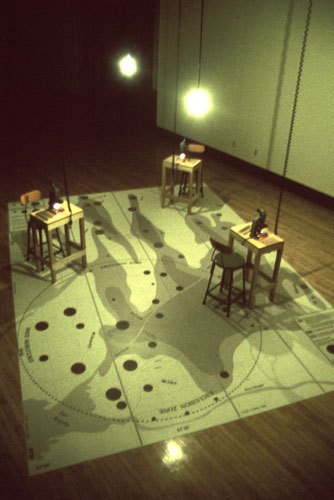

Exclusion Zone [1999]
Exclusion Zone is an installation of overlapping spatial narratives about the invisible effects of nuclear radiation. The work is named after the abstractly demarcated circular zone surrounding the Chernobyl nuclear reactor in the aftermath of its 1986 explosion. A 12'x 17' map marks the extent of the installation, and displays the abstract exclusion zone, the area actually affected by the radioactive fallout, and the sites of inhabitation that exist within this area of the Ukraine.
Three small tables each contain a microscope and a set of 20 glass slides, on which are printed (in microscopic text) fragments of the artist's first-person narrative about her experience with thyroid cancer – a cancer commonly attributed to radiation exposure but which is also medically treated with radiation. Working with the artificial construction of the circular exclusion zone and the cause-and-cure relationship of radiation to thyroid cancer as metaphors for the often troubling ways science deals with its own technological productions, Exclusion Zone creates a spatial experience for its audience.
Visitors to the installation must engage physically with the representation of the site of the Chernobyl Exclusion Zone in order to access the microscopes, and scientifically with the microscopes and slides to read the story of how an individual is made into a sort of moving exclusion zone when treated with radiation for cancer treatment.